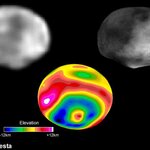Space

Einstein's general theory of relativity explained for us that the universe is elastic and gravity distorts space-time like we distort a couch when we sit on it. John Wheeler explained this perfectly when he wrote, "Matter tells space how to curve, and curved space tells matter how to move."
Now astronomers have seen Einstein’s predicted distortion of space-time around three neutron stars, and in doing so they have pioneered a groundbreaking technique for determining the properties of these ultradense objects. Neutron stars cram more than an entire Sun’s worth of material into a sphere the…

When white dwarf stars explode, they leave behind a rapidly expanding cloud of 'stardust' known as a Type Ia supernova. These exploding events, which shine billions of times brighter than our sun, are all presumed to be extremely similar, and thus have been used extensively as cosmological reference beacons to trace distance and the evolution of the Universe.
Astronomers have now – for the first time ever – provided a unique set of observations obtained with the ESO Very Large Telescope in Chile and the 10-meter Keck telescope in Hawaii, enabling them to find traces of the material that had…

Good lighting and high resolution cameras in the SMART-1 satellite are making it possible to put together the story linking geological and volcanic activity on the Moon.
“Thanks to low-elevation solar illumination on these high-resolution images”, says SMART-1 Project Scientist Bernard Foing, “it is now possible to study fine, small-scale geological features that went undetected earlier.”
The study provides new information on the thermal and tectonic history of the Moon and the processes following the formation of the large basins. There are approximately 50 recognizable lunar basins more…

Observations of solar flares by spacecraft at Mars, Venus and the Earth show that eruptions on the far side of the Sun may affect our “space weather” back on Earth.
In December 2006, a series of solar flares produced in a single active region were observed from three different points, each approximately 120 degrees apart. The results of these observations are now presented at the European Planetary Sciences Congress, Potsdam, on Thursday 23rd August by a team of scientists from the Swedish Institute of Space Physics.
Although solar flares and solar energetic particles (SEP) have been reported…

Analysis of the chemical make up of two asteroids in the outer asteroid belt has thrown the classification system for these small bodies, which orbit between Mars and Jupiter, into disorder.
Dr Rene Duffard, said, “We appear to have detected basalt on the surface of these asteroids, which is very unusual for this part of the asteroid belt. We do not know whether we have discovered two basaltic asteroids with a very particular and previously unseen mineralogical composition or two objects of non basaltic nature that have to be included in a totally new taxonomic class.”
The presence of basalt…
Astronomers have found an enormous hole in the Universe, nearly a billion light-years across, empty of both normal matter such as stars, galaxies and gas, as well as the mysterious, unseen “dark matter.” While earlier studies have shown holes, or voids, in the large-scale structure of the Universe, this new discovery dwarfs them all.
“Not only has no one ever found a void this big, but we never even expected to find one this size,” said Lawrence Rudnick of the University of Minnesota astronomy professor. Rudnick, along with grad student Shea Brown and associate professor Liliya Williams, also…

Images taken by Cassini’s Magnetospheric Imaging Instrument (MIMI) show that Saturn’s ring current is a warped disc that balloons out of the equatorial plane on the planet’s dayside and remains a thin disk that rises above the plane at larger distances on the nightside.
Dr Stamatios “Tom” Krimigis, the Principal Investigator for the instrument said, “Ring currents surround planets sort of like the brim of a hat. Uniquely in Saturn’s case, that brim has been crushed at the front and tipped up at the back, so it’s pretty bent out of shape!”
The presence of a ring current around Saturn was…

Located in the constellation Ursa Minor, and nicknamed Calvera after the villain in the movie "The Magnificent Seven", the new discovery will be only the eighth known "isolated neutron star", if confirmed, and the closest.
An isolated neutron star is one that does not have an associated supernova remnant, binary companion, or radio pulsations.
They chose that name for a special reason. "The seven previously known isolated neutron stars are known collectively as 'The Magnificent Seven' within the community and so the name Calvera is a bit of an inside joke on our part," says co-discoverer…

The question of whether Titan can retain its thick, organic atmosphere for the rest of its lifetime could hinge on how efficiently methane molecules were packed inside water “crates” during a period of the moon’s formation.
Dr Vasili Dimitrov, who spoke at the European Planetary Science Congress in Potsdam, said, “If Titan runs out of methane and loses its ‘veil’, it will become a completely different type of astrophysical body. Methane drives the chemical reactions in Titan’s atmosphere but, because it’s so highly reactive and therefore short-lived, it must be replenished. We need to find…

Yes, the sun has its own magical tune and if you want to hear it, click below. Even more interesting, the earth dances in rhythm.
David Thomson and Louis Lanzerotti, team members of the HISCALE experiment on board Ulysses, together with colleagues Frank Vernon, Marc Lessard and Lindsay Smith have proven that sounds generated deep inside the Sun cause the Earth to shake and vibrate in sympathy. They show that distinct, isolated tones, predicted to be generated by pressure and gravity waves in the Sun, are present in a wide variety of terrestrial systems.
Using statistical analysis they have…